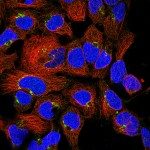Lien vers Pubmed [PMID] – 28275106
Open Biol 2017 03;7(3)
The disrupted-in-schizophrenia 1 () gene was identified as a genetic risk factor for chronic mental illnesses (CMI) such as schizophrenia, bipolar disorder and severe recurrent depression. Insoluble aggregated DISC1 variants were found in the cingular cortex of sporadic, i.e. non-genetic, CMI patients. This suggests protein pathology as a novel, additional pathogenic mechanism, further corroborated in a recent transgenic rat model presenting DISC1 aggregates. Since the potential role of aggregation of DISC1 in sporadic CMI is unknown, we investigated whether DISC1 undergoes aggregation in cell culture and could spread between neuronal cells in a prion-like manner, as shown for amyloid proteins in neurodegenerative diseases. Co-culture experiments between donor cells forming DISC1 aggregates and acceptor cells showed that 4.5% of acceptor cells contained donor-derived DISC1 aggregates, thus indicating an efficient transfer DISC1 aggregates were found inside tunnelling nanotubes (TNTs) and transfer was enhanced by increasing TNT formation and notably by dopamine treatment, which also induces DISC1 aggregation. These data indicate that DISC1 aggregates can propagate between cells similarly to prions, thus providing some molecular basis for the role of protein pathology in CMI.


